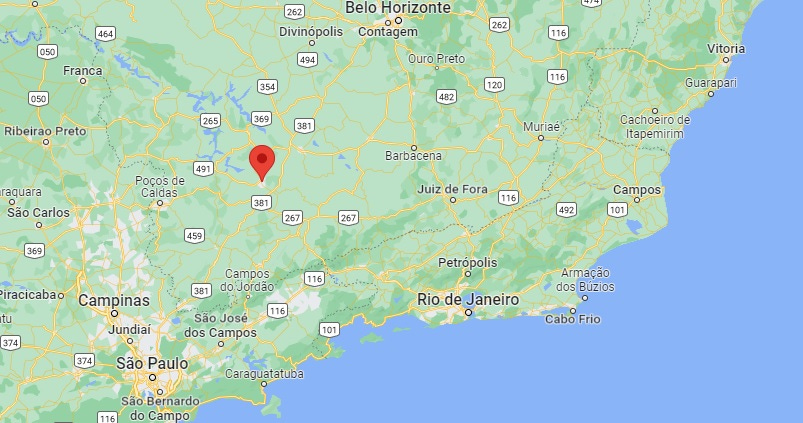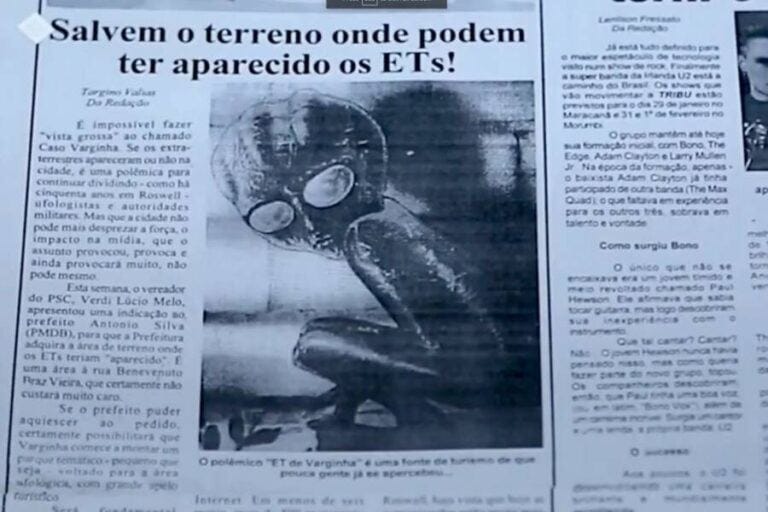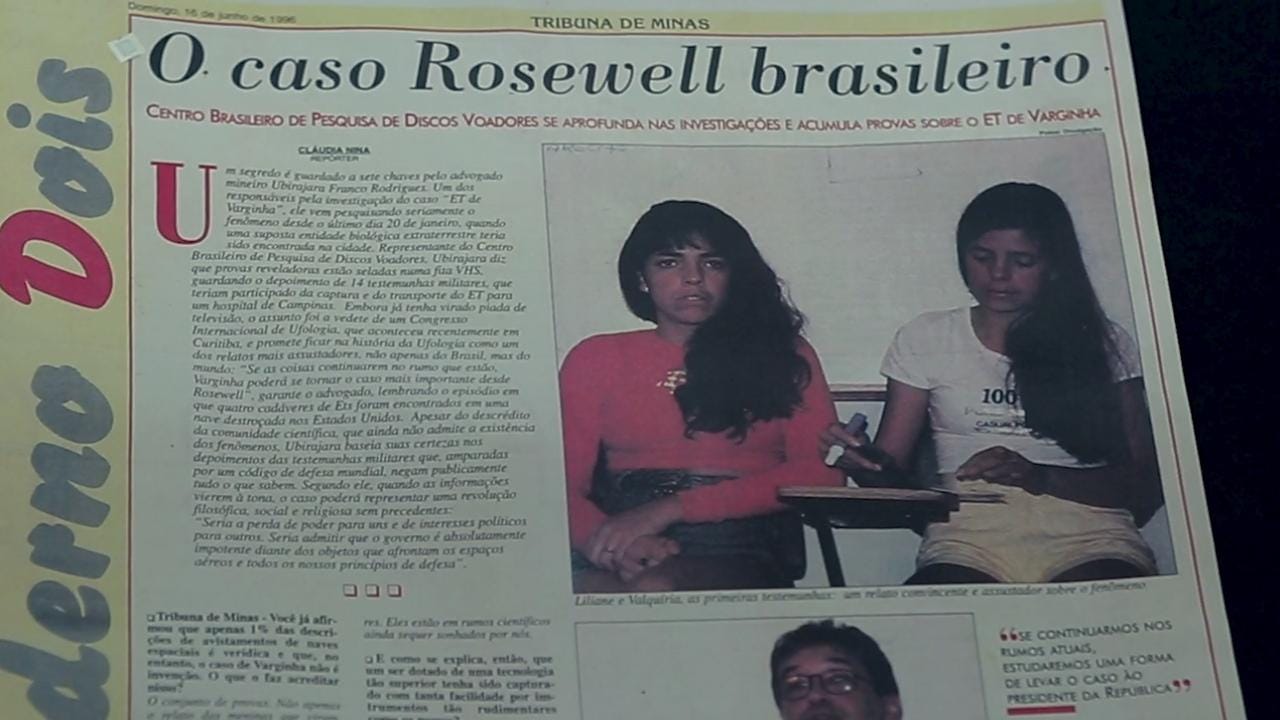The Varginha Encounter - Did Brazil's Military Capture a Living Alien in 1996?
A crashed UFO, red-eyed creatures in the streets, and a cover-up that may have cost a soldier his life—this is Brazil’s most chilling extraterrestrial case.
Case File: The Varginha UFO Incident
Case No.: 12MG-1996-BR
Classification: Extraterrestrial Encounter – Alleged UFO Crash and Biological Entity Retrieval
Location: Varginha, Minas Gerais, Brazil
Date of Incident: January 20, 1996
Filed by: Civilian Eyewitnesses, Brazilian Military Reports, and Independent UFO Investigators
Status: Closed – Civilian Reports Persist, Official Explanation Disputed
Incident Summary
On the morning of January 20, 1996, the quiet town of Varginha, located in the state of Minas Gerais, Brazil, became the epicenter of one of the most controversial and chilling UFO events in South American history. What began as a string of strange sightings and reports from local residents quickly escalated into a story involving unidentified creatures, military secrecy, and a death shrouded in mystery.
The first official reports surfaced when three young women—Lilian and Valquíria Silva, and their friend Katia Andrade Xavier—encountered what they described as a humanoid creature crouched beside a wall in an empty lot. The girls said the being had brown, oily skin, a large head, bulging red eyes, and appeared to be weak or injured. They ran home in terror, prompting their mother to investigate the area, where she too confirmed seeing something unnatural. The event was quickly reported to local authorities.
Later that day, military vehicles and personnel were seen in the area, and multiple eyewitnesses observed the capture of what they believed to be a non-human entity. Some claimed the military had recovered the body of a second creature, possibly already dead. Others insisted that one of the beings was transported to a hospital and later died under unexplained circumstances.
In the following days, a series of interlinked testimonies emerged. Local firefighters were allegedly dispatched to aid in the capture of the beings. An unusual number of military trucks were seen entering and leaving ESA (Escola de Sargentos das Armas), a local army base. Eyewitnesses described seeing crates being loaded onto unmarked aircraft. Even more disturbingly, some locals—including a prominent veterinarian—claimed they were coerced into silence after seeing the creature or its remains.
Perhaps the most haunting aspect of the case involves the sudden illness and death of 23-year-old military police officer Marco Eli Chereze, who was reportedly involved in one of the captures. Chereze died from a mysterious infection weeks after the encounter, and his family reported that the military refused to release details about what he had been exposed to. Autopsy records were sealed, and the official explanation offered no clear cause of death.
Despite repeated denials from Brazilian military and government officials, the Varginha incident continues to generate speculation and debate. Investigators believe the creature sightings were the result of a UFO crash that had taken place days earlier, with the Brazilian government launching a covert operation to recover both the craft and its occupants.
Multiple independent researchers and ufologists—both in Brazil and abroad—have gathered eyewitness accounts, photos, and testimonies suggesting an orchestrated military cover-up. The incident, which became known as “Brazil’s Roswell,” remains one of the most disturbing and unexplained UFO encounters ever recorded.
Phenomena Overview
The Varginha incident was marked by a series of bizarre and disturbing phenomena that unfolded over the course of several days in January 1996. While initially centered around the sighting of strange creatures, the case quickly expanded to include aerial anomalies, biological hazards, and an aggressive military response—each layer deepening the unsettling nature of what occurred in the town.
Unidentified Aerial Activity
In the days leading up to January 20, multiple residents of southern Minas Gerais, including neighboring towns such as Tres Corações and Jardim Andere, reported seeing a large, cigar-shaped flying object hovering silently in the sky. Witnesses described it as metallic, damaged, and moving slowly with an erratic flight path, as if it were experiencing mechanical failure. Several stated that the craft emitted smoke or steam and made no audible noise.
Military radar allegedly tracked an unidentified object descending in the area, though official statements later denied any unusual activity. Ufologists believe this object crash-landed in the rural outskirts of Varginha, prompting a rapid and secretive recovery operation by the Brazilian military.
Creature Sightings and Description
The most infamous element of the case centers around sightings of a strange biological entity—possibly more than one—that was described consistently across numerous, unrelated eyewitnesses.
Physical Description: The creature was said to be approximately 4–5 feet tall, with a disproportionately large head, ridged skull, and thin limbs. Witnesses claimed its skin was dark brown, smooth yet oily in appearance, and emitted a strong ammonia-like odor. Its most terrifying feature was a pair of oversized, glowing red eyes. The being appeared weak, frightened, and vulnerable—either injured or sick.
Behavior: Unlike the classic portrayals of hostile extraterrestrials, the entity reportedly displayed no aggression. Instead, it seemed disoriented, sluggish, and in distress. Witnesses described it crouching or huddling near walls and brush, attempting to shield itself from view.
At least two separate sightings occurred on January 20, and some believe multiple creatures were seen over the following days—both alive and dead.
Military Retrieval Operations
Soon after the creature sightings were reported, witnesses began to observe an unusually high military presence in Varginha. Army trucks, unmarked vehicles, and personnel in hazmat-like gear were seen canvassing key areas where the creature had last been seen. Soldiers were allegedly seen retrieving a body from a ditch and placing it into a wooden crate, which was then transported to the local military base. Eyewitnesses also described troops cordoning off public roads and intimidating bystanders.
One of the most disturbing accounts came from the staff at a local hospital, where a large military convoy arrived without warning and reportedly seized an entire wing of the building. Medical professionals later claimed a "non-human patient" had been brought in—briefly treated—and then removed by soldiers.
Physical and Biological Contamination
There are reports suggesting that whatever was recovered posed a biological risk. Witnesses mentioned seeing soldiers in full protective suits handling the remains, and a veterinarian later claimed to have been brought in to examine the creature. Days later, Military Police Corporal Marco Eli Chereze, who had reportedly assisted in one of the captures, fell ill and died of a mysterious infection. His death certificate listed “toxemia” and “immune system failure,” but his family was never given clear answers.
Rumors of chemical containment and quarantine protocols circulated among the locals, though the military denied any biological threat.
Ongoing Disturbances and Suppression
In the aftermath, many of the witnesses and their families reported being visited by military or government officials who warned them to remain silent. Some claimed they were intimidated, while others were allegedly offered financial compensation for their silence.
Despite these efforts, the incident sparked a wave of paranoia in the region. Locals reported feeling an oppressive atmosphere in the days following the event—strange noises at night, flickering lights, and a general sense that something unnatural had occurred in their quiet town.
Press Coverage and Public Reaction
The Varginha incident ignited a media firestorm across Brazil in the days following the initial creature sighting. At first, it was treated by local outlets as a curiosity—a small-town oddity fueled by folklore and imagination. But as more witnesses came forward, and as the military presence in Varginha became undeniable, national and international press outlets began to take a serious interest. What began as rumors of a strange creature would evolve into one of the most talked-about UFO stories in Latin American history.
Local Media Breaks the Story
The first coverage came from Radio Melodia, a local Varginha station that aired an interview with the girls who saw the creature. Their emotional, detailed account quickly caught the attention of listeners. Local newspapers, such as Tribuna de Minas, picked up the story and published the girls’ sketches of the entity. Within 48 hours, the streets of Varginha were filled with journalists, photographers, and curious onlookers.
Initially dismissed as a hoax or urban legend, the story took a darker turn when multiple unrelated residents reported seeing military trucks, soldiers in hazmat gear, and a heavy presence at the local hospital. Press attention intensified.
National Headlines and Widespread Panic
Major Brazilian TV networks like Rede Globo and SBT ran segments on the sightings, featuring both witnesses and skeptics. By the end of January 1996, the Varginha case had become front-page news nationwide. Some headlines dubbed it “O ET de Varginha” (The Varginha ET), while others posed uncomfortable questions about why the military was behaving as if it were handling a biological emergency.
The imagery was compelling: terrified children, soldiers in masks, hospitals locked down. The Brazilian public, already familiar with tales of the paranormal and spiritualism, reacted with a mix of fascination, fear, and suspicion. Parents kept children indoors. Schools saw lower attendance. The town became a spectacle, with tourists arriving in hopes of catching a glimpse of something otherworldly.
Official Denials Fuel Conspiracy Theories
As media pressure mounted, the Brazilian military released statements denying any extraterrestrial involvement. They claimed that reports of a “creature” were simply misidentifications of a homeless man with disabilities and that the increased military traffic in the area was part of a routine training exercise.
These explanations were met with widespread public skepticism. News programs ran side-by-side images of the alleged "homeless man" and the girls’ sketches—highlighting obvious inconsistencies. Citizens accused authorities of lying and suppressing the truth. Public trust in the official narrative rapidly eroded.
The unexplained death of Corporal Marco Eli Chereze, who had allegedly helped capture the creature, became a lightning rod for public outrage. His family’s refusal to accept the military’s explanation added fuel to growing conspiracy theories that the government was hiding something far more serious.
International Attention and UFO Community Response
Word of the incident soon crossed borders. International UFO researchers, especially from the United States, began investigating the case. Major UFO organizations, including MUFON and CUFOS, issued bulletins on “the Brazilian Roswell,” and began sending investigators to South America.
American TV networks like the History Channel and Discovery aired segments on the Varginha case, often featuring it in UFO specials alongside Roswell and Rendlesham Forest. The incident became a fixture in global UFO lore—an alleged alien encounter with credible witnesses, a suspicious military response, and a tragic human cost.
Pop Culture and Tourism
Over the years, Varginha embraced its bizarre legacy. The city erected a spaceship-shaped water tower and adopted the alien motif in public artwork, signage, and local festivals. What began as terror eventually evolved into tourism.
The case inspired books, documentaries, graphic novels, and merchandise. Yet behind the commercialization, many locals—especially the original witnesses—remained haunted by what they saw and the pressure they endured to stay silent.
Modern-Day Reactions and Resurgence
With the release of James Fox’s 2022 documentary Moment of Contact, which featured new whistleblower interviews and on-the-record testimonies from key witnesses, public interest in the Varginha case surged once again. Many who had dismissed the incident as myth were forced to reconsider.
Online discussions exploded. Hashtags like #VarginhaUFO and #BrazilianRoswell trended across social media. Reddit threads, podcasts, and YouTube channels reignited debates. Some journalists even began pushing for the Brazilian government to declassify any documents related to the 1996 operation.
The public response remains split—some see it as a clear cover-up, others as mass hysteria. But few deny that something deeply strange happened in Varginha… and that the full truth has never been told.
The Story
Varginha was never meant to be the center of controversy and unnatural events. Tucked into the rolling hills of Minas Gerais, the town moved at a gentle pace—coffee farms, cobbled streets, and the ordinary sounds of life drifting on the breeze. But in January of 1996, the hum of routine was shattered by something that did not belong. Something that fell from the sky.
It began not with lights, but with smoke. In the days before the creature sighting, locals in nearby towns described seeing a strange, metallic craft—cigar-shaped, silent, and damaged—drifting through the air. Some said it sputtered like a wounded animal; others saw it plunge behind the trees in the early hours of morning. There was no explosion. Just an eerie stillness. Whatever had crashed, it seemed, had not died on impact.
On the morning of January 20, three young women—Kátia Xavier, and sisters Liliane and Valquíria Silva—walked through an overgrown lot in the Jardim Andere district. The air was heavy, damp from recent rain. That’s when they saw it.
Crouched near a concrete wall was a figure—small, trembling, and utterly shocking. Its skin was a sickly, oily brown, glistening in the daylight. Its body was thin, skeletal even, and it had a large, bulging head with ridges along the crown. But the most terrifying part—the part that would haunt the girls forever—were its eyes. Enormous, deep red, but filled with fear.
The girls ran, screaming, convinced they’d seen the devil. Their mother returned with them moments later and confirmed it: there had been something there. By the time authorities arrived, it was gone. But the air still smelled like ammonia, and neighbors whispered about soldiers showing up long before anyone had called them.
Later that same day, other witnesses spotted a convoy of military trucks driving through the streets of Varginha. Uniformed men cordoned off streets, entered alleyways, and reportedly retrieved something—some say alive, some say not. Residents watched from behind curtains as crates were loaded into unmarked vehicles. One man, a local taxi driver, claimed to have seen a “shaking creature, like a child in pain,” being loaded into a truck by men in full hazmat gear. His account was dismissed by officials.
Days later, a second being was allegedly captured. This time, it was taken to a local hospital. Several staff members would later report that the military abruptly took over part of the facility, forcing them out. Some described a pungent stench in the hallways. One surgeon claimed he had been ordered to assist with a “non-human patient,” and later received a direct warning not to speak of it again.
Then came the death.
Marco Eli Chereze, a 23-year-old military police officer, was reportedly involved in capturing one of the beings. Within days, he fell gravely ill. His body deteriorated rapidly—vomiting, fever, immune failure. The diagnosis was vague: sepsis, possibly brought on by some unknown contaminant. He died within weeks. His mother, distraught, said the military refused to tell her what he had been exposed to. His autopsy was sealed. She believes—until her final breath—that her son died because he touched something he never should have seen.
The army issued an official explanation. The creature, they claimed, was merely a local homeless man—mentally ill, dirty, hunched over. They said the trucks were routine exercises. The hospital seizure was never explained. The soldiers in hazmat suits? Not mentioned.
But few in Varginha believed any of it.
People remembered the smell. They remembered the fear. And they remembered the look in those red eyes.
Over the years, the town changed. Murals of aliens appeared. Statues. Souvenirs. The creature became a mascot. The military, meanwhile, moved on. Records went missing. Witnesses disappeared from public life, and those who still spoke of it did so in whispers. The girls, now grown, never retracted their story.
And then, nearly three decades later, a whistleblower emerged. In Moment of Contact (2022), a former military insider—his face blurred, voice altered—said what many had feared. That a craft did crash. That biological entities were recovered. And that one of them was alive. He claims it was taken to a facility and eventually… vanished.
No photos were ever released. No footage has surfaced. Only fragments remain: a town that remembers, a mother without answers, and a story that refuses to die.
So what really happened in Varginha?
Did a non-human craft crash in rural Brazil? Did frightened soldiers retrieve a creature that was never meant to be seen? Or was it, as officials insist, mass hysteria triggered by a city’s overactive imagination?
There are no easy answers. Only questions that grow louder with time.
And eyes—still glowing red—in the memories of those who swear they saw them.







